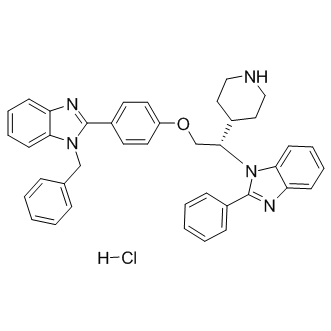Deltarasin hydrochloride |
| Catalog No.GC12060 |
inhibitor of KRAS-PDEδ interaction, potent and selective
Products are for research use only. Not for human use. We do not sell to patients.

Cas No.: 1440898-82-7
Sample solution is provided at 25 µL, 10mM.
Deltarasin hydrochloride is a selective inhibitor of KRAS-PDEδ interaction with IC50 value of 41±12 nM [1].
KRAS, also known as V-Ki-ras2 Kirsten rat sarcoma viral oncogene homolog, is a protein and works as a molecular on/off switch whose mutant is an essential step in the development of many cancers. PDEδ (prenyl binding protein) controls the spatial organization of K-Ras, which enhances Ras diffusion in the cytosol. Inhibition of the Ras-PDEδ interaction by small molecules impairs Ras localization and signaling has becoming a promising strategy to treat cancers in clinic [1, 2].
Deltarasin hydrochloride is a potent KRAS-PDEδ interaction inhibitor. When tested with human pancreatic ductal adenocarcinoma cells Deltarasin hydrochloride showed inhibition on KRAS-PDEδ interaction to inhibit oncogenic RAS signaling and suppressed cell proliferation by binding to PDEδ with Kd value of 41 nM [1].
In nude mice model with Panc-Tu-I xenograft, administration of Deltarasin hydrochloride (10, 15 mg/kg) impaired cells growth and decreased tumor volume after 9 days in a dose-dependent manner [1].
References:
[1]. Zimmermann, G., et al., Small molecule inhibition of the KRAS-PDEdelta interaction impairs oncogenic KRAS signalling. Nature, 2013. 497(7451): p. 638-42.
[2]. The KRAS-PDEdelta interaction is a therapeutic target. Cancer Discov, 2013. 3(7): p. Of20.
Kinase experiment: | KD values are measured by fluorescence polarization measurements. For direct titrations, increasing amounts of PDEδ are added to a solution containing 50-100 nM labelled small molecule in 200 µL PBS buffer. For displacement titrations, increasing amounts of the small molecules in DMSO are directly added to fluorescein-labelled atorvastatin (24 nM) and His6-tagged PDEδ (40 nM) in 200 µL PBS-buffer (containing 0.05% CHAPS, 1% DMSO), keeping the concentration of fluorescein-labelled atorvastatin, PDEδ and DMSO constant. For KD measurements using isothermal titration calorimetry, PDEδ protein (280 µM) is titrated to small molecule (30 µM) in Tris/HCl buffer (temperature 25°C). In the Tm shift assays, protein melting points are detected by circular dichroism spectroscopy in the presence of small molecules. |
References: [1]. Zimmermann G, et al. Small molecule inhibition of the KRAS-PDEδ interaction impairs oncogenic KRAS signalling. Nature. 2013 May 30;497(7451):638-42. | |
| Cas No. | 1440898-82-7 | SDF | |
| Chemical Name | (S)-1-benzyl-2-(4-(2-(2-phenyl-1H-benzo[d]imidazol-1-yl)-2-(piperidin-4-yl)ethoxy)phenyl)-1H-benzo[d]imidazole hydrochloride | ||
| Canonical SMILES | [H][C@@](C1CCNCC1)(N2C3=CC=CC=C3N=C2C4=CC=CC=C4)COC5=CC=C(C6=NC7=CC=CC=C7N6CC8=CC=CC=C8)C=C5.Cl | ||
| Formula | C40H38ClN5O | M.Wt | 640.22 |
| Solubility | DMF: 30 mg/ml,DMSO: 30 mg/ml,Ethanol: 30 mg/ml,PBS (pH 7.2): 10 mg/ml | Storage | Store at -20°C |
| General tips | Please select the appropriate solvent to prepare the stock solution according to the
solubility of the product in different solvents; once the solution is prepared, please store it in
separate packages to avoid product failure caused by repeated freezing and thawing.Storage method
and period of the stock solution: When stored at -80°C, please use it within 6 months; when stored
at -20°C, please use it within 1 month. To increase solubility, heat the tube to 37°C and then oscillate in an ultrasonic bath for some time. |
||
| Shipping Condition | Evaluation sample solution: shipped with blue ice. All other sizes available: with RT, or with Blue Ice upon request. | ||
| Prepare stock solution | |||

|
1 mg | 5 mg | 10 mg |
| 1 mM | 1.562 mL | 7.8098 mL | 15.6196 mL |
| 5 mM | 0.3124 mL | 1.562 mL | 3.1239 mL |
| 10 mM | 0.1562 mL | 0.781 mL | 1.562 mL |
Step 1: Enter information below (Recommended: An additional animal making an allowance for loss during the experiment)
 g
g
 μL
μL

Step 2: Enter the in vivo formulation (This is only the calculator, not formulation. Please contact us first if there is no in vivo formulation at the solubility Section.)
Calculation results:
Working concentration: mg/ml;
Method for preparing DMSO master liquid: mg drug pre-dissolved in μL DMSO ( Master liquid concentration mg/mL, Please contact us first if the concentration exceeds the DMSO solubility of the batch of drug. )
Method for preparing in vivo formulation: Take μL DMSO master liquid, next addμL PEG300, mix and clarify, next addμL Tween 80, mix and clarify, next add μL ddH2O, mix and clarify.
Method for preparing in vivo formulation: Take μL DMSO master liquid, next add μL Corn oil, mix and clarify.
Note: 1. Please make sure the liquid is clear before adding the next solvent.
2. Be sure to add the solvent(s) in order. You must ensure that the solution obtained, in the previous addition, is a clear solution before proceeding to add the next solvent. Physical methods such as vortex, ultrasound or hot water bath can be used to aid dissolving.
3. All of the above co-solvents are available for purchase on the GlpBio website.
Quality Control & SDS
- View current batch:
- Purity: >99.50%
- COA (Certificate Of Analysis)
- SDS (Safety Data Sheet)
- Datasheet
Average Rating: 5 (Based on Reviews and 35 reference(s) in Google Scholar.)
GLPBIO products are for RESEARCH USE ONLY. Please make sure your review or question is research based.
Required fields are marked with *



















